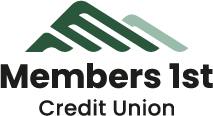
Fall Financial Checkup
Fall is a season of change. The days get shorter, leaves turn golden, and many of us start preparing for the busy months ahead. It’s also the perfect time to pause and take a closer look at your finances before the year ends.
At Members 1st, we encourage our members to use this season as a checkpoint — a moment to reflect, adjust, and make sure you’re on track to meet your goals. Here are five key things to review in your fall financial checkup.
1. Revisit Your Budget
As the year winds down, your spending patterns may look different than they did in January. Holiday shopping, travel, and rising utility costs in the cooler months can all put extra pressure on your wallet.
Questions to ask yourself:
- Am I spending more than I planned in certain categories?
- Do I have room to set aside money for upcoming holiday expenses?
- Should I adjust my savings contributions to balance seasonal costs?
Tip: Use digital banking tools to track your spending automatically. Seeing where your money goes can help you spot opportunities to cut back and redirect funds to savings or debt repayment.
2. Check In on Debt
High-interest debt (like credit cards) can sneak up fast. Fall is a great time to evaluate where you stand and create a plan to pay it down.
What to do:
- Make a list of balances, interest rates, and minimum payments.
- Focus on paying off the highest-interest accounts first (the “avalanche method”) or knock out small balances for quick wins (the “snowball method”).
- Consider whether a personal loan or balance transfer card could help consolidate debt and lower your interest rate.
Tip: Even a small extra payment each month can save you hundreds in interest over time.
3. Review Your Credit Report and Score
Your credit health affects everything from loan approvals to interest rates. Fall is the perfect time to review your credit before the new year.
Steps to take:
- Get your free annual credit report from annualcreditreport.com.
- Check for errors like accounts you don’t recognize or incorrect payment histories.
- Pay attention to your credit utilization, keeping it below 30% helps boost your score.
Tip: If you find errors, dispute them right away. Fixing mistakes can improve your score and save you money in the future.
4. Maximize Benefits and Savings
Before December 31, make sure you’re getting the most out of employer benefits, retirement accounts, and tax-advantaged savings.
Things to review:
- Flexible Spending Accounts (FSAs): Use the funds before they expire.
- 401(k) or IRA contributions: Increase them if you haven’t met the yearly limit.
- Employer match: Don’t leave free money on the table, contribute enough to get the full match.
- Health insurance: Review your current plan during open enrollment and adjust if your needs have changed.
Tip: Even small increases in retirement contributions add up over time thanks to compound growth.
5. Set Your Goals for the Year Ahead
Fall is the gateway to a fresh start. Think about what you want to achieve financially in the next 12 months and set yourself up for success.
Ideas to consider:
- Build or replenish your emergency fund.
- Save for a major purchase (home, car, vacation).
- Increase retirement savings by 1–2%.
- Plan ahead for education costs or family milestones.
Tip: Write your goals down and revisit them quarterly. Small, consistent steps lead to big progress.
A fall financial checkup helps you close out the year with clarity and confidence. By reviewing your budget, debt, credit, benefits, and goals, you’ll not only finish strong but also set yourself up for success in the new year!




